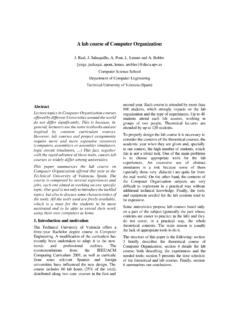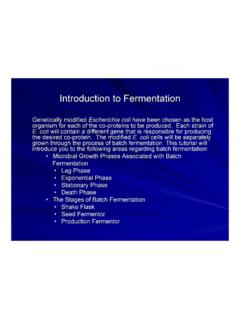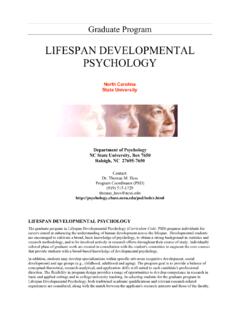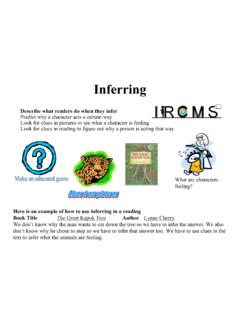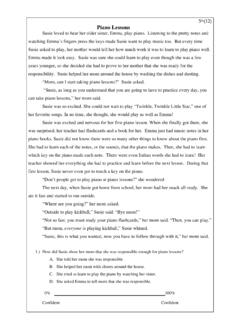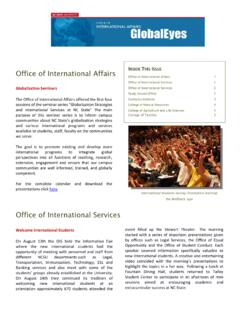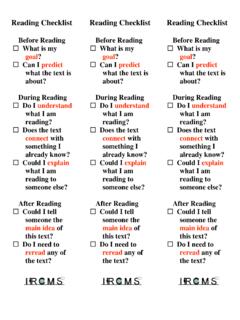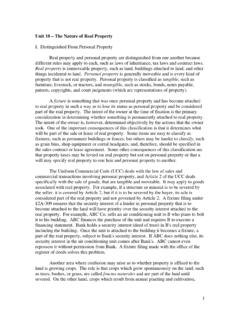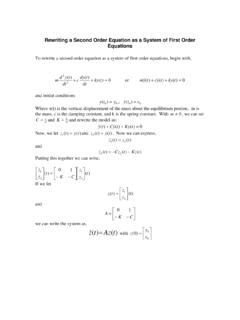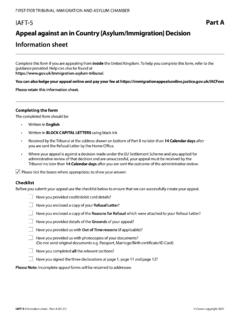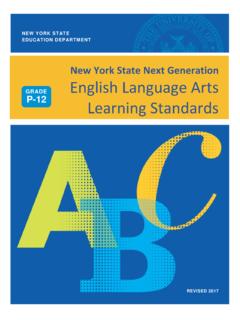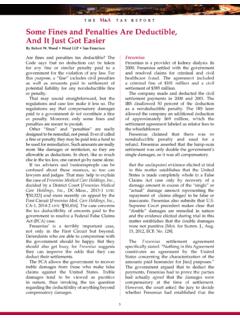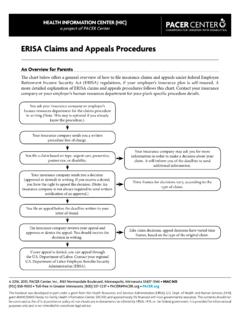Transcription of Universal Design Features in Houses - NCSU
1 Universal Design IN HOUSING Prepared by: THE CENTER FOR Universal Design North Carolina State University College of Design Campus Box 8613 Raleigh, NC 27695-8613 (Voice and TTY) (FAX) Revised 1/06 Universal Design : The Definition Universal Design is the Design of products and environments to be usable by all people, to the greatest extent possible, without the need for adaptation or specialized Design . The intent of the Universal concept is simply life for everyone by making more housing usable by more people at little or no extra cost. Universal Design is an approach to Design that incorporates products as well as building Features and elements which, to the greatest extent possible, can be used by everyone. While accessible or adaptable Design requirements are specified by codes or standards for only some buildings and are aimed at benefiting only some people (those with mobility limitations), the Universal Design concept targets all people of all ages, sizes, and abilities and is applied to all buildings.
2 What is a Universal Design feature? Any component of a house that can be used by everyone regardless of their level of ability or disability. Universal Features are generally standard building products or Features that have been placed differently, selected carefully, or omitted. For example, standard electrical receptacles can be placed higher than usual above the floor, standard but wider doors can be selected, and steps at entrances can be eliminated to make housing more universally usable. The composition of our population is changing. Many people are surviving permanently disabling accidents and illness and even more are living longer. It would seem logical that the spaces built to ac-commodate this population must, by necessity, change also. The building and Design industries have responded to this need for change by producing special products and spaces for special groups. But special is often synonymous with expensive . Specialization leads to complicated building standards and products which, in the end, seldom meet the needs of more than a fraction of those they were meant to help and often seem to stigmatize and separate them further from other people.
3 Universal Design succeeds because it goes beyond specialization. The concept promotes designing every product and building so that everyone can use them to the greatest extent possible every faucet, light fixture, shower stall, public telephone, or entrance. Universal Design is a revolutionary but practical leap forward in the evolution of building and Design procedures. When designers and manufacturers seize this concept, Universal Design will become common, convenient, and profitable.. Excerpted from Universal Design : Housing for the Lifespan of all People, by Ron Mace for the Department of Housing and Urban Development, 1998 # Structural Feature { Non-structural Feature CENTER FOR Universal Design y UD Features in Housing y 2/21/06 3 Universal Design Features in Housing The following list of characteristics are elements, Features , ideas or concepts that contribute to or can be components of Universal housing.}
4 This list is intended as a guide. The Features described are those we might look for in Universal housing but not all are expected to be included in any given home. Some are finite recommendations, some are lists of options, and some are scope statements identifying how many particular Features must or should be included. Obviously, the more Universal Design characteristics or Features included, the more usable the house. A key component of Universal Design is the market appeal it adds to the home because the Universal Features are integrated into the overall Design . Done well, Universal Design becomes a virtually invisible element. This list contains structural and non-structural Features . Structural Features , indicated by #, should be considered for new homes and major renovations. Non-structural Features , indicated by {, are less expensive and easier to incorporate into a finished home. CHARACTERISTICS BENEFITS Entrances Stepless Entrances # It is best to make all home entrances stepless.}
5 # More than one stepless entrance is preferred. # At least one stepless entrance is essential; if only one, not through a garage or from a patio or raised deck. Easier to move furniture and appliances in and out. Great for baby strollers and bicycles. Easier to bring in groceries and packages. Safer in wet or icy condtions. Easier to clear snow, ice and leaves. Easier than steps to repair and maintain. Site Design Methods for Integrated Stepless Entrances # Level bridges to uphill point. # Driveway and garage elevated to floor level so vehicles do the climbing. # Earth berm and bridge with sloping walk. # Site grading and earth work (with foundation waterproofing) and sloping walks at 1:20 maximum slope. # Avoid ramps. If ramps are used, integrate into the Design . Slope of route is shallow making travel from parking to door easier. # Structural Feature { Non-structural Feature CENTER FOR Universal Design y UD Features in Housing y 2/21/06 4 CHARACTERISTICS BENEFITS Other Entrance Features # One-half inch maximum rise at entrance thresholds.}
6 Reduces tripping hazards. Dollies and handtrucks move over easily. # Minimum 5 x 5 level clear space inside and outside entry door. (Can be smaller if automatic power door provided.) # Power door operators whenever possible. Allows for maneuvering while opening or closing door. # Weather protection such as a porch, stoop with roof, awning, long roof overhang, and/or carport. o Built-in shelf, bench or table with knee space below located outside the door. Provides sheltered space for people while unlocking the door, waiting for a carpool, making deliveries, etc. Less weather damage to door finish. Provides a place to put packages while opening doors. # Full length sidelights, windows in doors, and/or windows nearby. o Wide-angle viewers and TV monitors. Allows all residents, including children and people using wheelchairs to see who is at the door before opening it. o Lighted doorbell at a reachable height, intercom with portable telephone link, and/or hardwired intercom.
7 Allows visitors to communicate with residents. o Light outside entry door and motion detector controlled lights. View of approaching visitors. Adds general illumination and sense of security. Illuminates lockset. Eliminates dark approaches to the home. o House number should be large, high contrast, located in a prominent place. Easy for friends and emergency personnel to locate residence. Interior Circulation # An open plan Design . Minimizes hallways and doorways and maximizes sight lines. # At least one bedroom and accessible bathroom should be located on an accessible ground floor entry level (same level as kitchen, living room, etc.). # Structural Feature { Non-structural Feature CENTER FOR Universal Design y UD Features in Housing y 2/21/06 5 CHARACTERISTICS BENEFITS # Clear door opening width (32 minimum, 34 - 36 wide doors), for all doorways. # Flush thresholds at all doorways.}
8 Improves circulation, especially with many visitors, such as at parties. Reduces damage to door jambs when moving large furniture or appliances, equipment, ladders. # Clear floor space (18 minimum) beside door on pull side at latch jamb. Provides space to move out of the way of the door swing when pulling it open. # Circulation route 42 minimum width. # Turning space in all rooms (5 diameter). Provides maneuvering room in the hallways and archways. Vertical Circulation # All stairs should be appropriate width and have space at the bottom for later installation of a platform lift, if needed. If a two-story dwelling: # at least one set of stacked closets, pantries, or storage spaces with knock-out floor OR # a residential elevator with minimum 3 x 4 clear floor area installed at the time of initial construction. # Stair handrails to extend horizontally beyond top and bottom risers. Easy access between floors. Becomes shaft for later elevator installation- at a great cost savings.
9 Steady users at top and bottom of stairs Bathrooms When more than one bathroom is provided, all should meet the following criteria, including bathrooms on the second floor. # At least one bathroom must have one of the following accessible bathing fixtures: minimum 5 x 3 (4 preferred), curbless shower OR tub with integral seat, waterproof floor, and a floor drain. # Structural Feature { Non-structural Feature CENTER FOR Universal Design y UD Features in Housing y 2/21/06 6 CHARACTERISTICS BENEFITS # Other bathrooms in the same house may have a tub with an integral seat or a 3 x 3 transfer shower with L shaped folding seat and 1/2 maximum lip (curb) in lieu of fixtures described above. When possible, arrange at least one shower control for right-hand use and one for left-hand use. # Adequate maneuvering space: 60 diameter turning space in the room and 30 x 48 clear floor spaces at each fixture.}
10 Spaces may overlap. Allows people to sit in tub/shower without needing additional equipment. # Clear space (3 ) in front and to one side of toilet. # Toilet centered 18 from any side wall, cabinet, or tub. Allows for easy maneuvering to and around toilet. Provides space for transfers to and from toilet. # Broad blocking in walls around toilet, tub, and shower for future placement and relocation of grab bars. o Grab bars should not be stainless steel or chrome. Use colors to match decor. Allows for custom placement of grab bars after construction without opening wall to add blocking. Grab bars make it easier and safer for everyone to get in and out of the tub or shower. Grab bars also double as towel bars but are more durable. # Lavatory counter height 32 minimum. o Knee space under lavatory (29 high). May be open knee space or achieved by means of removable vanity or fold-back or self-storing doors. Pipe protection panels must be provided to prevent contact with hot or sharp surfaces.
